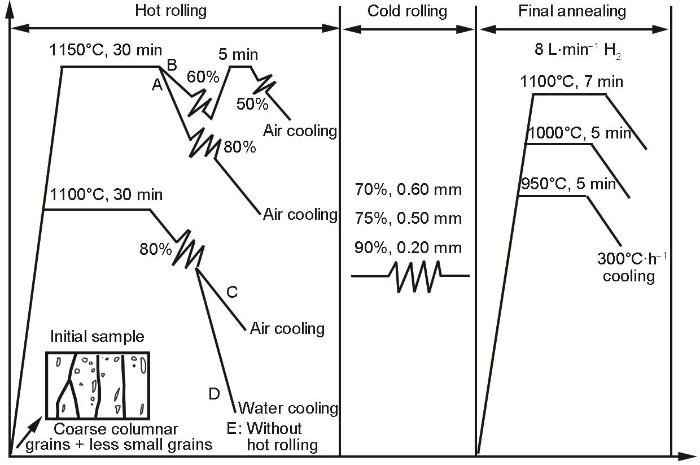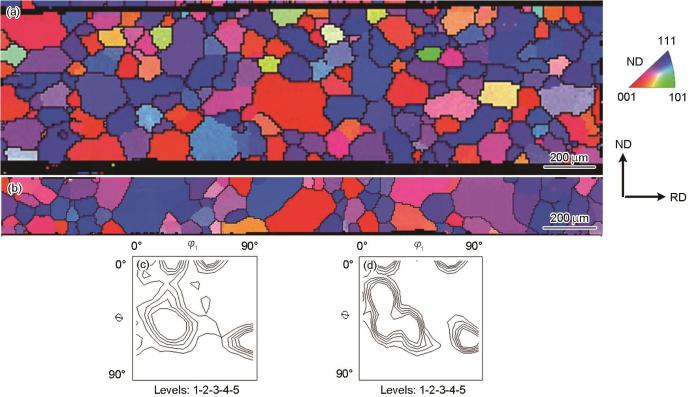通常研究人员更加关注高硅高牌号、无相变电工钢的研究,这是因为虽然有相变的低牌号电工钢(如1300~800牌号)的生产成本和技术门槛低、产量高,但其对应的磁性能(尤其是铁损)差,导致产品利润低。同时,有相变的低牌号电工钢组织转变要比高牌号无相变的电工钢复杂得多,其复杂性在于其生产的全工艺环节中会出现3个阶段的奥氏体-铁素体之间的相变过程:第一阶段是连铸过程,第二阶段是热轧加热及热轧过程,第三阶段是冷轧后的最终退火过程。前两阶段的相变会依次对第三阶段的相变造成影响,即连铸过程的相变程度将影响热轧过程的相变程度及组织织构,并进一步影响冷轧相变退火后的组织织构。然而,目前针对这3个阶段相变的组织织构转变的报道很少。
目前工业上低牌号电工钢的生产现状为:热轧阶段经充分的奥氏体化,轧制时奥氏体向铁素体充分相变,从而在热轧板中形成均匀的细晶组织。这种细晶组织导致在随后的冷轧再结晶退火中,初始晶粒尺寸的影响超过初始织构的影响,最终形成强{111}<112>的有害织构[1~5],其对应的{111}晶粒的面积分数可达40%左右。因此,从磁性能的角度来看,奥氏体-铁素体之间的相变是不利的。综上,目前三阶段相变的研究情况是:对连铸过程的相变尚未加以关注;在热轧阶段的相变控制(即充分相变)则是导致热轧板中产生不利的细晶组织;在最终退火阶段则是避开高温相变处理,只采取低温再结晶退火。针对热轧板中不利的细晶组织,有文献[2~7]已报道了粗化初始晶粒尺寸的研究,如提高热轧的终轧温度[3]、提高卷取温度[4]或模拟高温卷取的低温退火方法[2,5],甚至采用常化工艺[6,7]。这些研究在一定程度上优化了磁性能,但都未对相变过程进行有针对性的控制。
本课题组[8~12]前期对实验室冶炼的无硅及低硅电工钢采用特殊的相变法进行最终退火,显著强化了{100}织构,粗化了晶粒尺寸,并形成特有的双层柱状晶组织,从而有效改善了磁性能。这些结果与Sung等[13~15]的结果一致。此类强{100}织构被称为表面效应诱发的相变织构,而这种相变法是否适用于工业成分的电工钢尚不明确。此外,工业低牌号电工钢连铸坯中被观察到普遍存在{100}柱状晶组织[16~18],且准原位测定表明,这些柱状晶是凝固后的柱状晶的相变受到抑制造成的,即不同成分电工钢连铸坯均存在显著的相变抑制,即使再加热到1150℃,仍能观察到残留的{100}区域。需要注意的是,1300牌号电工钢连铸坯在实验室条件下(分别为1150和1100℃加热热轧)形成的热轧组织中{100}残留区域大小有明显差异[1],推测这是加热时相变滞后或相变被抑制所致。即柱状晶的相变滞后易造成热轧组织受加热温度和保温时间的影响,这表明第一阶段连铸过程的相变行为影响了第二阶段热轧过程的相变行为。由此提出第二个问题,受相变滞后影响的热轧组织对冷轧退火的再结晶织构及第三阶段的相变织构是否有影响。
1 实验方法
实验采用与前期工作[1]中相同的材料和实验方法,即选用厚度为230 mm的1300牌号电工钢连铸坯,初始组织主要为柱状晶,其主要化学成分为Fe-0.002C-0.35Si-0.13Mn-0.14P-0.18Al-0.0021S (质量分数,%)。通过膨胀法测得原始材料冷却(降温速率300℃/h)时奥氏体向铁素体转变的开始温度(Ar3)为973℃,奥氏体向铁素体转变的终止温度(Ar1)为938℃。使用Thermo-Calc软件计算出的平衡态下奥氏体向铁素体转变的开始温度(A3)和平衡态下奥氏体向铁素体转变的终止温度(A1)分别为1070和960℃。将原始连铸坯中柱状晶的长轴方向平行于板法向切成厚为10 mm的样品,然后按图1所示对其依次进行热轧-冷轧-最终退火工艺。使用4种热轧工艺A、B、C和D,得到的样品分别称为A、B、C和D样品。热轧总压下率均为80%,A和B样品热轧加热温度为1150℃,A样品为热连轧获得;B样品为热轧60%后,在1150℃保温5 min后再热轧50%获得;A和B热轧后均为空冷。C和D样品热轧加热温度为1100℃,C样品热轧后空冷,D样品热轧后水冷。热轧板厚度为2 mm。冷轧压下率分别为70%、75%和90%,得到的冷轧板厚度分别为0.60、0.50和0.20 mm。作为对比,柱状晶(E样品)直接冷轧并相变退火也列入其中。然后将冷轧样品在1100℃的纯H2气氛下进行相变退火,H2流量为8 L/min,冷却速率为300℃/h。为了考察退火温度的影响,对低温热轧且热轧板中{100}晶粒较多的C和D样品还进行了950和1000℃的退火。基于上述平衡相变点的计算,这2个温度分别对应铁素体区的再结晶退火和两相区退火。
图1
图1
样品轧制及退火工艺流程图
Fig.1
Schematic of rolling and annealing process routes (Inset shows the schematic of microstructure of initial sample)
将最终的退火板进行切割、磨抛及侵蚀。放入装配电子背散射衍射(EBSD)探头以及Channel 5取向分析系统的Supra55扫描电镜(SEM)中进行组织形貌和微观取向分析。晶粒尺寸是通过EBSD取向成像数据中每个晶粒的面积等效计算出的直径而确定的,并统计所有晶粒从而得到平均晶粒尺寸。利用NIM-2000E硅钢单片磁性能测量仪对实验中制得的电工钢成品板进行检测,样品尺寸为50 mm (轧向,RD) × 50 mm (横向,TD),获取样品2个面4个方向的磁感应强度(B50)及铁损(P1.5),再分别计算沿RD及TD的磁性能均值。
2 实验结果
2.1 不同压下量下样品相变退火组织与织构
图2[1]为4种热轧工艺(即图1所示的A、B、C和D工艺)下形成的热轧组织的EBSD取向成像图。显然,不同工艺下的热轧组织存在明显差异。高温1150℃热轧(工艺A和B)得到的热轧板主要包括细晶及形变程度较小的组织(图2a和b)。B工艺因中间插入了保温过程,导致实际热轧形变量只有50%,低于A工艺(80%),故热轧组织中等轴晶的晶粒尺寸稍大(图2b),且中心层存在{100}取向的晶粒(图2f),而A工艺下形成了典型的轧制剪切织构(图2e)。相比之下,低温1100℃热轧(工艺C和D)得到的热轧板中形成了形变组织(图2c和d),C工艺下的热轧板中心层含有一定数量的{100}取向晶粒(图2g),D工艺下的热轧样品则具有较强的{100}织构(图2h)。结合柱状晶相变被显著推迟甚至抑制的结果[16,18]以及晶粒尺寸和组织均匀性与相变点的对应关系[17],可知,C和D工艺下热轧板中的形变铁素体是高温加热时相变被推迟的结果,也就是部分铁素体轧制。由于热轧形变量较低(只有80%,工业板大约为98.9%),因此有大量的{100}取向晶粒被保留。
图2
图2
不同热轧工艺下样品的EBSD取向成像图及取向分布函数(ODF)图(φ2 = 45°)[1]
Fig.2
Inverse pole figure (IPF)-Z maps (a-d) and orientation distribution function (ODF) figures at φ2 = 45° section (e-h) for through-thickness cross section of hot rolling samples in processes A (a, e), B (b, f), C (c, g), and D (d, h), respectively[1] (φ1, Φ, φ2—Euler angles; RD and ND represent rolling direction and normal direction of the sheet, respectively; IPF-Z represents the projection of the grain orientations that are parallel to ND in the crystal coordinate system)
图3为A~E工艺下获得的样品经75%冷轧(0.50 mm厚度)、1100℃相变退火后的EBSD取向成像分析。图4为对应的平均晶粒尺寸。前期研究[1]表明,这组热轧样品在82.5%冷轧压下量下(板厚为0.35 mm),相变处理后的组织及织构差异较小。然而,从图3可以看出,75%的较低压下量的冷轧板经相变法退火后的组织织构存在明显差异。A、B工艺下,相变退火后的组织具有强的{111}织构(图3a、b、f、g),这显然是热轧板初始晶粒尺寸小的缘故,即初始细晶组织冷轧退火后形成强{111}相变织构;而C、D工艺下,相变退火后的样品中存在较多的近{100}或{114}取向的晶粒,遗传了热轧板中的{100}织构(图3c、d、h、i)。尽管没有观察到从板材上下表面相变形核并向中心层定向生长的组织特征,但初始织构存在明显的影响。另外,作为对比的柱状晶直接冷轧(E工艺)并相变退火的样品,也显示了更有利的织构(图3e和j)。样品中不仅存在较多{100}取向的晶粒,还具有较多的{110}取向的晶粒,推测是冷轧中出现剪切带,退火时{110}取向的晶粒在剪切带上形核生成,随后相变发生遗传所致。图4中的平均晶粒尺寸表明,5种不同工艺下退火组织的平均晶粒尺寸分别为(112.6 ± 70.3)、(88.3 ± 50.0)、(120.2 ± 73.1)、(122.6 ± 80.4)和(102.0 ± 61.8) μm,均远大于工业成品板的晶粒尺寸(25 μm[1]),但晶粒尺寸波动很大。
图3
图3
4种热轧样品和1种柱状晶初始样品经冷轧(0.50 mm、75%压下量)后1100℃保温7 min相变退火的EBSD取向成像图和ODF图(φ2 = 45°)
Fig.3
IPF-Z maps (a-e) and ODF figures (φ2 = 45°) (f-j) for through thickness cross section of annealed samples at 1100oC for 7 min after cold rolling (0.50 mm, 75% reduction) in the hot rolling processes A (a, f), B (b, g), C (c, h), D (d, i), and E (e, j), respectively
图4
图4
4种热轧样品和1种柱状晶初始样品经冷轧(0.50 mm、75%压下量)后1100℃保温7 min相变退火组织的平均晶粒尺寸
Fig.4
Average grain sizes of annealed samples at 1100oC for 7 min after cold rolling (0.50 mm, 75% reduction) in different hot rolling processes
图5为A~E工艺下获得的样品冷轧90% (板厚为0.20 mm)后,再在1100℃相变退火后的EBSD取向成像分析。图6为对应的平均晶粒尺寸。可以看出,90%冷轧下最终形成的相变组织特征与75%冷轧下的相似,工艺A和B下的相变退火样品同样具有强{111}织构,差别在于此时的丝织构不连续(图5a、b、f、g)。工艺C和D下,则主要是α*线织构(大致在{114}<481>-{113}<361>-{112}<421>取向位置),而没有{100}织构(图5c、d、h、i)。这是因为冷轧形变量太大,α线织构对应的形变长条晶粒内、晶界附近或不同取向过渡区域中原残留的{100}取向转变为{114}-{112}<uvw>取向,再结晶后这些区域形成的再结晶晶粒继承了这种取向,最终相变退火后呈现出遗传型相变织构。因此相变退火除了受初始组织的影响,还受冷轧压下量的影响,且其影响规律与再结晶织构所受的影响规律基本相同。柱状晶(工艺E获得样品)冷轧并相变退火后的织构不同于4种热轧板冷轧退火后的相变织构(图5e和j),这主要是初始组织不同造成的,一方面连铸坯中存在粗大的{100}取向的晶粒,另一方面也存在较多细小等轴的以{111}取向为主的相变变体晶粒。在大压下量冷轧过程中,晶粒间因尺寸、取向的差异而相互作用,产生的形变不均匀区取向较随机,形成了非典型的再结晶织构,相变后继承了再结晶织构。图6的平均晶粒尺寸数据表明,5种不同工艺下退火组织的平均晶粒尺寸分别为:(93.4 ± 56.6)、(98.9 ± 63.8)、(114.5 ± 89.4)、(96.2 ± 68.2)和(84.4 ± 59.7) μm。该晶粒尺寸也远大于工业板的平均晶粒尺寸(25 μm[1])。通常,随着冷轧形变量增大,再结晶晶粒变细,若相变退火过程中加热温度相对较低,没有显著发生奥氏体的不均匀长大,相变退火后形成的铁素体晶粒尺寸也小。对比图4和6可见,样品基本符合这个规律,只有B工艺样品例外。
图5
图5
4种热轧样品和1种柱状晶初始样品经冷轧(0.20 mm、90%冷轧压下量)后1100℃保温7 min相变退火后的EBSD取向成像图和ODF图(φ2 = 45°)
Fig.5
IPF-Z maps (a-e) and ODF figures (φ2 = 45°) (f-j) for through thickness cross section of annealed samples at 1100oC for 7 min after cold rolling (0.20 mm, 90% reduction) in the hot rolling processes A (a, f), B (b, g), C (c, h), D (d, i), and E (e, j), respectively
图6
图6
4种热轧样品和1种柱状晶初始样品经冷轧(0.20 mm、90%冷轧压下量)后1100℃保温7 min相变退火组织的平均晶粒尺寸
Fig.6
Average grain sizes of annealed samples at 1100oC for 7 min after cold rolling (0.20 mm, 90% reduction) in different hot rolling processes
2.2 最终退火温度的影响
图7
图7
低温热轧样品(C工艺)冷轧后在950℃退火5 min的EBSD取向成像图与ODF图(φ2 = 45°)
Fig.7
IPF-Z maps (a, b) and ODF figures (φ2 = 45°) (c, d) for through thickness cross section of annealed samples at 950oC for 5 min after different cold rolling processes in the hot rolling process C (a, c) 0.60 mm, 70% reduction (b, d) 0.20 mm, 90% reduction
图8
图8
低温热轧样品(D工艺)冷轧后在950℃退火5 min的EBSD取向成像图和ODF图(φ2 = 45°)
Fig.8
IPF-Z maps (a, b) and ODF figures (φ2 = 45°) (c, d) for through thickness cross section of annealed samples at 950oC for 5 min after different cold rolling processes in the hot rolling process D (a, c) 0.60 mm, 70% reduction (b, d) 0.20 mm, 90% reduction
图9为1100℃低温热轧板(C工艺)冷轧(70%及90%压下率)后在1000℃退火的EBSD取向成像分析。本工作计算的平衡相变点A1、A3分别为960和1070℃,因此1000℃在两相区,保温5 min后应该发生较大程度的相变。图9a和c表明,相比950℃退火(图7a和c),C工艺热轧样品经70%冷轧后在1000℃两相区退火形成的组织中{100}<021>取向晶粒增多。随冷轧形变量增大至90% (图9b和d),{100}取向晶粒沿ND偏离立方取向,且{114}<481>取向晶粒增多,与图3和5中的结果具有相同规律。此外可以看出,相变介入形成的织构优于950℃退火下的再结晶织构。{100}取向晶粒有随着相变发生而增加的趋势。
图9
图9
低温热轧样品(C工艺)冷轧后1000℃退火5 min的EBSD取向成像图和ODF图(φ2 = 45°)
Fig.9
IPF-Z maps (a, b) and ODF figures (φ2 = 45°) (c, d) for through thickness cross section of annealed samples at 1000oC for 5 min after different cold rolling processes in the hot rolling process C (a, c) 0.60 mm, 70% reduction (b, d) 0.20 mm, 90% reduction
图10为低温加热热轧板(D工艺)冷轧(70%及90%压下率)后在1000℃两相区退火后的EBSD取向成像分析。可见,与不同热轧工艺、相同退火温度下(C工艺)的样品相比(图9),此时由于低温加热热轧样品中{100}取向晶粒较多(图2d和h),冷轧退火后,形成的{100}取向晶粒增多。特别是较低的70%压下量下(图10a和c),{100}取向晶粒最多。90%压下量下(图10b和d),{100}取向晶粒较少,但{114}<481>织构增强,这是冷轧形变量过大的缘故。虽然发生了部分相变,但没有出现由板材表层形核并长入中心层的表面效应诱发相变的组织特征。晶粒尺寸的不均匀性,晶粒内部形变储能的差异,导致相变处理时,得不到均匀整齐的由表层长入中心层的双层柱状晶组织。但晶粒尺寸的巨大差异没有导致{100}织构的消失。由于相变温度区间太大,相变点高,相变应变累计不够,导致冷却相变时,表层{100}取向晶粒难以发生形核及同步向板中心的定向生长。
图10
图10
低温热轧样品(D工艺)冷轧后1000℃退火5 min的EBSD取向成像图与ODF图(φ2 = 45°)
Fig.10
IPF-Z maps (a, b) and ODF figures (φ2 = 45°) (c, d) for through thickness cross section of annealed samples at 1000oC for 5 min after different cold rolling processes in the hot rolling process D (a, c) 0.60 mm, 70% reduction (b, d) 0.20 mm, 90% reduction
综合比较上述2.1节相变织构与2.2节再结晶织构和部分相变织构的结果可知,4种热轧工艺中,1100℃低温加热热轧板C和D最终退火后的织构更好。原因是连铸坯柱状晶相变滞后的作用使得低温热轧保留了更多的{100}取向晶粒,且其在冷轧最终退火后能够保留较多的{100}或{114}取向晶粒。此外,1000℃两相区退火的织构优于950℃下的再结晶织构,即再结晶织构(图7和8)中含{100}或{114}取向晶粒一般比相变织构(图3和5)中少,说明相变织构还不完全是简单的再结晶织构的继承。在热轧后空冷(C工艺)和热轧后水冷(D工艺)样品中,D工艺下的热轧板中具有更多的{100}取向形变晶粒,最终冷轧织构中残留的{100}取向晶粒也更多,说明形变的{100}取向晶粒在随后的90%压下量下也能保留,但一般不是准确的{100}取向。最后,结果表明了初始{100}织构的保留与冷轧压下量的一般规律,即低压下量更有利于保留{100}织构,但仍存在显著的组织不均匀性。
2.3 磁性能对比
图11为A~E工艺获得的样品在2种冷轧压下量(75%、0.50 mm和90%、0.20 mm)下最终1100℃相变退火5 min后的磁性能。由图11a和b可见,对于较低冷轧压下量(75%)的样品,1100℃低温加热(工艺C和D)对应的最终样品的磁感高,甚至高于柱状晶直接冷轧后相变退火的样品,但磁感的各向异性较大。4种热轧工艺对应的最终样品铁损相差不大,E工艺直接冷轧对应的样品铁损最大,推测是晶粒尺寸不均匀所致。对90%大压下量的厚度较薄的5种样品,1100℃低温加热(工艺C和D)对应的最终样品的磁感及铁损都优于1150℃高温加热(工艺A、B)对应的最终样品,但幅度不大。而直接冷轧对应的样品磁感最高,B50达到1.84 T,与前期工作[1]中0.35 mm厚(82.5%压下量)的退火板磁感相同,见图11c和d。随厚度进一步减薄,铁损进一步降低,工艺C样品沿RD最低可到3.2 W/kg,这是薄规格板材的厚度效应所致。
图11
图11
不同热轧样品经不同压下量冷轧后在1100℃保温7 min相变退火的样品的磁性能
Fig.11
Iron loss (P1.5) (a, c) and magnetic induction (B50) (b, d) of transformation annealed samples at 1100oC for 7 min after different cold rolling processes in hot rolling processes A-E, respectively (TD—transverse direction)
(a, b) 0.50 mm, 75% reduction (c, d) 0.20 mm, 90% reduction
3 分析讨论
上述实验结果给出了不同热轧组织在不同形变量及不同退火温度下的组织与织构。热轧组织的差异本质上是连铸坯柱状晶相变滞后导致铁素体轧制时{100}织构遗传的问题。退火温度的影响涉及遗传型和表面效应诱发型相变织构的相互关系,以及与再结晶织构的差异对比。而初始组织均匀性是这些过程中不可避免的影响因素。
3.1 表面效应诱发型相变织构与遗传型相变织构
作者在总结性文章[19]中提出,按冷轧样品相变处理时加热温度的高低,可出现2种相变织构。一是低相变温度处理下的遗传型织构[20],此时相变织构基本为再结晶织构,通常以{111}织构为主。但如果再结晶织构中{100}取向的晶粒因{100}初始织构的存在而增多,遗传型相变织构中{100}织构也增强,见热轧温度不同的4个样品中的C和D样品,显示了初始组织对遗传型相变织构的影响。二是高相变温度处理的表面效应诱发型相变织构,此时形成完全不同于再结晶织构的新型织构,且在bcc结构的钢中为{100}织构。根据热力学计算的相变点,本工作中的1300电工钢在1100℃加热进行相变处理时,只有30℃的过热度,远低于实验室制备的无Al、无Si电工钢具有的100℃的过热度[8,9,21,22]。即本工作得到的是遗传型相变织构,而不是表面效应诱发型相变织构,且不是典型的双层柱状晶组织。就磁性能来说,表面效应诱发型相变织构优于遗传型相变织构,对于本工作中工业成分合金,若继续提高相变处理温度有可能得到表面效应诱发的相变织构,理论上减弱{111}织构。但温度过高不仅不节能,轧板的板形也得不到保障,企业难以采纳。只有不加入Al、P元素,降低表面氧化及表面偏析,同时合金的相变点会明显下降,表面效应诱发的{100}相变织构才会出现。虽然本工作在相变处理温度较低(1100℃)的条件下得到的遗传型相变织构中也显示了有利的{100}织构,但其{100}取向晶粒的面积分数低于不含Al、P的电工钢[8,9,11]。另外需要注意的是,遗传型相变织构通常是在普通冷却方式下得到的[20],而本工作均采用了纯H2喷吹板表面方式的特殊相变法,所以尽管相变织构以遗传型为主,但仍优于再结晶织构,见图3、5、7、8中C、D样品的织构。
3.2 柱状晶保留{100}织构与相变织构的关系
对无相变的高牌号电工钢,可通过连铸坯中{100}柱状晶热轧、常化、冷轧及再结晶退火工艺的优化,尽可能保留初始{100}织构,提高成品板磁性能,这在本课题组前期工作[23~26]中都得以验证。由于低牌号电工钢柱状晶连铸坯显著的相变滞后,导致热轧时容易出现较大程度的铁素体热轧而避开了奥氏体转变,即C和D工艺,这本质上是亚稳铁素体的热轧。因此,低牌号电工钢存在柱状晶{100}织构的保留或遗传问题。同时柱状晶热轧、冷轧退火时具有组织不均匀现象。为了考察初始不均匀组织中的{100}织构对最终相变织构的影响,对柱状晶样品直接冷轧并相变退火(E工艺),前期工作[1]和本工作结果均表明直接冷轧再相变处理的样品通常包含多数{100}和{110}取向的晶粒,并具有高磁性。结合3.1节讨论,可以明确的是初始{100}织构有利于遗传型{100}相变织构。关于初始组织的不均匀性对表面效应诱发的{100}相变织构的影响,由于本工作中工业电工钢含较高的Al和P,阻碍了表面诱发效应的产生[1],因此还不能完全确定其影响的程度。这里引用文献[22,23]中的数据来分析。其使用了实验室冶炼的成分为Fe-0.5Mn的初始柱状晶组织,并分为直接冷轧和热轧后冷轧2种工艺,对比相变退火后的组织和织构,表明2种情况都可以制备出较强的、具有典型双层柱状晶组织的{100}相变织构。此外,柱状晶经不同压下量直接冷轧造成不同程度的不均匀组织。一方面,铸坯(50 mm厚)经50%冷轧后,对应的组织很不均匀;另一方面,铸坯在90%冷轧下,形成了强{111}再结晶织构,但2种情况经相变处理后均获得典型的表面效应诱发相变的组织。
综上所述,在成分设计合适的条件下,即减少工业产品现工艺下有利、但对相变法不利的Al、P元素的加入量,初始组织中的{100}柱状晶在一系列工艺后(如热轧、冷轧、最终的相变处理),残留的{100}取向晶粒在最终相变处理时就可顺利地在板表层形核,此时热轧板中具有{100}取向的组织的尺寸不均匀性的缺点或不足将得到一定的改善。
4 结论
(1) 低温热轧样品中较强的{100}形变织构有利于随后冷轧退火后得到较多的{100}或{114}取向的晶粒,而高温加热充分相变的热轧样品,因细晶尺寸效应强化了冷轧退火后的强{111}相变织构。当初始组织为细晶时,晶粒尺寸效应对最终相变织构的影响超过初始织构的影响。
(2) 冷轧压下量对最终相变织构具有不同的影响。对于保留较多{100}取向形变晶粒的低温加热热轧板,较低的冷轧压下量有利于最终相变退火后获得更多的{100}取向晶粒。而高温加热热轧板对应细晶初始组织,在不同冷轧压下量下均为强{111}及{112}相变织构。75%和90%冷轧样品最终相变退火后平均晶粒尺寸大于工业再结晶成品板的晶粒尺寸,有利于降低铁损。
(3) 随冷轧板最终退火温度的降低,即由1100℃的奥氏体单相区降到1000℃的两相区,再到950℃的铁素体区,低温热轧样品相变退火后的织构类型逐渐呈现再结晶织构的特点,{111}织构增强。
(4) 1100℃低温加热热轧、冷轧及相变退火的样品C和D的磁性优于1150℃高温充分相变热轧、冷轧再相变退火的样品A和B的磁性。
参考文献
The influence of rolling process on the microstructure, texture and magnetic properties of low grades non-oriented electrical steel after phase transformation annealing
[J].Non-oriented electrical steel sheets are important metallic functional materials for the iron cores in transformers and electrical motors, which require the performance characteristics of low iron loss and high magnetic induction. The magnetic properties of electrical steel critically depend on the microstructure and the occurring texture components. In addition, alloy elements can affect the magnetic properties by altering the electrical resistivity, microstructure and texture. At present, the quality of commercial non-oriented electrical steels are mainly optimized by the control of deformation, recrystallization parameters and chemical composition. And the microstructure, texture and magnetic properties are significantly influenced by the rolling process before recrystallization annealing. The favorite {100} texture in such condition takes at maximum only about 20% in volume fraction. In contrast, phase transformation combined with deformation can lead to nearly 80% volume fraction of {100}-oriented grains. In this work, the influence of rolling process on the microstructure, texture and magnetic properties of low grades non-oriented electrical steel after phase transformation annealing was studied by means of EBSD, XRD and magnetism measuring techniques. The starting material is a columnar-grained industrial low grades electrical steel cast slab. Five different initial microstructures are obtained after different rolling processes, the α→γ→α phase transformation annealing of samples is conducted in a tube furnace under H2 atmosphere. The results show that phase transformation annealing can significantly coarsen grains and reduce the iron loss of non-oriented electrical steels compared with traditional recrystallization annealing. And the phase transformation texture is influenced by texture memory. Compared with hot rolling-cold rolling process, more {100}-oriented grains are obtained and the magnetic properties of non-oriented electrical steels are improved significantly after phase transformation in the directly cold rolling process. The proportion of non-{111} oriented grains increases and more initial {100}-oriented grains are retained after phase transformation in the process with lower hot rolling temperature, which improve the magnetic properties of final sample. In addition, the presence of P and Al elements in commercial electrical steels may affect the microstructure, texture and magnetic properties of non-oriented electrical steels due to segregation and oxidation after phase transformation.
轧制工艺对低牌号无取向电工钢相变退火组织、织构与磁性能的影响
[J].
Effects of coiling temperature after hot rolling on microstructure, texture, and magnetic properties of non-oriented electrical steel in strip casting processing route
[J].
Effect of finishing temperature on magnetic properties of medium and low grade non-oriented silicon steel
[J].
终轧温度对中低牌号无取向硅钢磁性能的影响
[J].
Effects of hot-rolled coiled temperature on microstructure, texture and magnetic properties of low silicon non-oriented electrical steels
[J].
热轧卷取温度对低硅无取向硅钢组织、织构及磁性能的影响
[J].
Fabrication of high-performance low silicon non-oriented electrical steels by a new method: Low-finishing-temperature hot rolling combined with batch annealing
[J].
Effect of hot-band grain size on magnetic properties of non-oriented electrical steels
[J].
Effects of normalizing treatment on microstructure, texture and magnetic properties of 50 W800 electrical steel
[J].
常化处理对50W800电工钢组织、织构与磁性的影响
[J].
Microstructure and texture evolution in a non-oriented electrical steel during γ→α transformation under various atmosphere conditions
[J].
Formation of {100} textured columnar grain structure in a non-oriented electrical steel by phase transformation
[J].
Texture optimization for intermediate Si-containing non-oriented electrical steel
[J].
Influence of processing parameters on microstructures, textures and magnetic properties in a Fe-0.43Si-0.5Mn electrical steel subjected to phase transformation treatment
[A].
相变法制备Fe-0.43Si-0.5Mn电工钢时工艺参数对组织结构和磁性能的影响
[A].
Improvement of texture and magnetic properties by surface effect induced transformation in non-oriented Fe-0.82Si-1.37Mn steel sheets
[J].
Efficient generation of cube-on-face crystallographic texture in iron and its alloys
[J].
Magnetic properties of Fe and Fe-Si alloys with {100} <0vw> texture
[J].
Evolution of crystallographic texture in pure iron and commercial steels by γ to α Transformation
[J].
Transformation delay and texture memory effect of columnar grained cast slab in low grades non-oriented electrical steels
[J].
Effect of the initial columnar-grained inhomogeneity of electrical steels on the transformation temperature
[J].
Formation of {100} subgrain variants and Σ3 variants during phase transformation of columnar grains in electrical steel: Texture memory and variant selection
[J].
On the transformation textures influenced by deformation in electrical steels, high manganese steels and pure titanium sheets
[J].Transformation texture is normally different to deformation and recrystallization textures, thus influencing materials properties differently. As deformation and recrystallization are often inseparable to transformation in materials which shows a variety in types such as diffusional or non-diffusional transformations, different phenomena or rules of strengthening transformation textures occur. This paper summarizes the complicated phenomena and rules by comparison of a lot of authors’ published and unpublished data collected from mainly electrical steels, high manganese steels and pure titanium sheets. Three kinds of influencing deformation are identified, namely the dynamic transformation with concurrent deformation and transformation, the transformation preceded by deformation and recrystallization and the surface effect induced transformation, and the textures related with them develop in different mechanisms. It is stressed that surface effect induced transformation is particularly effective to enhance transformation texture. It is also shown that the materials properties are also improved by controlled transformation textures, in particular in electrical steels. It is hoped that these phenomena and processing techniques are beneficial to the establishment of transformation texture theory and property improvement in practice.
Memory effects of transformation textures in steel and its prediction by the double Kurdjumov-Sachs relation
[J].
Columnar grain growth in non-oriented electrical steels via plastic deformation of an initial columnar-grained solidification microstructure
[J].
Growth and strain behavior of columnar grains in Fe-0.5%Mn alloy by hot-rolling
[J].
Preparation of non-oriented silicon steel with high magnetic induction using columnar grains
[J].
Retaining {100} texture from initial columnar grains in electrical steels
[J].
{001}<120>-{113}<361> recrystallization textures induced by initial {001} grains and related microstructure evolution in heavily rolled electrical steel
[J].
















